 |
|
KASTELA - FROM ANCIENT TIMES TO THE PRESENT
The beautiful Adriatic sea, somewhere in the middle of it's
croatian coast, sneaked in between the island of Ciovo and
the peninsula of Marijan, at the bottom of mountain Kozjak,
forming the bay of Kastela, positioned in the sun's travelling
path. The area between Kozjak and the sea, with its beauty,
mildness and fertility has always attracted people. To the
prehistoric man it gave shelter; centuries ago it was covered
with villas and planted with Mediterranean plants like vines
and olives. The barbarians devasted it in the early middle
ages. The Croats settled here in the seventh century and created
here the centre of their state. Here they converted to Christianity
and built their settlements along the slopes of the Kozjak
mountain. During the war with Turks they moved from the mountain
villages towards fortifications erected by royals along the
coast, in order to protect themselves and their peasants.
Thus, 500 years ago there was a significant development of
some twenty castles, fortifications, of which nowadays only
seven are preserved. Around them settlements were sprouting
to finally merge together into the town of Kastela. Seven
little stone pearls in one shell; the magic number 7 will
always remain the symbol of richness and variety of our town.
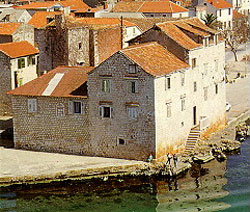 |
KASTEL STAFILIC
The fortification with the yard, today known as the
tower Rotonda, was built in 1508 by Stjepan Stafileo
on a rock embedded in the sea, as protection against
the Turks. He had a grapestaphile (greek) carved into
his seal. Next to the castle a fortified village was
established, surrounded by a channel and a moveable
bridge with protection towers, of which one is still
preserved in it's original form. People from the area
of Bijaci settled here. |
| KASTEL NOVI
Pavao-Antun Cipiko, royalty from Trogir, build in 1512
a fortified summer palace with slanting ground floor
walls and next to it a settlement for the peasants from
Kozjak villages, the largest of which was the one surrounding
the church of Lady of Stomorije.
The castle gives an impression of a stronghold, but
the decorated balconies and windows point to it's comfortable,
homely purpose. |
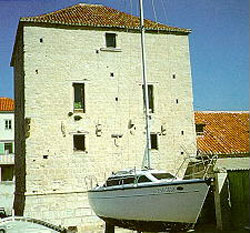 |
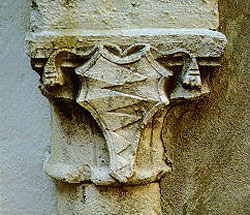 |
KASTEL STARI
Koriolan Cipiko, from a famous family of Trogir, a
commander in the Levante wars, about which he also wrote,
was the first to build a castle in the sea for protection
from intruders. He built a castle which was a combination
of fortress and a palace. It was separated from the
coast by a channel and connected to it with a moveable
bridge (brvno); thus the name, castle Brce (brvce).
Beneath it's walls people from Radun and from Svecurje
settled, while in the vacated place a typical old Croat
church, the church of St. Juraj, remained. |
KASTEL LUKSIC
The Brothers Vitturi, royals from Trogir, build a very
beautiful castle in 1564 for their families and as protection
for their peasants who were more and more often attacked
by Turks in their village Ostrog on the Balovan ridge.The
northern side with two towers and the slanting ground
floor walls, joined with the mainland by a moveable
bridge has a particularly defensive appearance. The
southern side has a balcony and an emergency exit towards
the sea. The expansive yard of the palace is separated
by a hall and galleries on the southern side.
This castle, known locally as Dobrila's, is closely
associated with the nearby Miljenko's castle through
a legend about a tender, tragic love. |
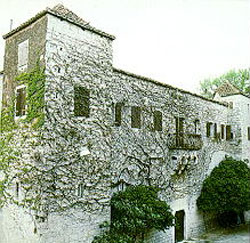 |
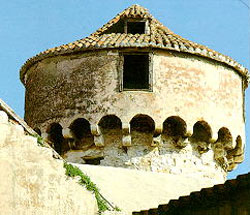 |
KASTEL KAMBELOVAC
The brothers Cambi from Split built in 1517 a deterrent
castle on a small rock in the sea in order to protect
themselves and the inhabitants from the nearby villages
Lazani and Krusevik, situated below the Kozjak mountain.
There were numerous smaller fortifications, but the
best preserved one is this castle with a specific cylindrical
form which eased the defenders' activities. In its vicinity
there is also th preserved village gate. |
KASTEL GOMILICA
In 1529 the benedictine sisters built this fortification
(kastel)) on a sea reef called Gomilica. The castle's
entrance was protected by a tower erected above a stone
bridge permeated with arcades. At the entrance there
was a moveable wooden bridge.
Between the walls of this castle inhabitants from Gornje
and Donje Kozice moved in a settled down after the Turks
destroyed their villages. Maybe the sisters planted
also the 7 centuries old Medunac oak at the church of
St. Kuzma and Damjan, one of the oldest churches in
Kastela. |
 |
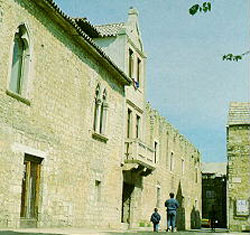 |
KASTEL SUCURAC
The first safeguarding tower on the shore was built
by the archbishop Andrija Gualdo in 1392 on a stone
hillside in todays Kastel Sucurac.
With several subsequent modifications the fortification
was expanded, especially in 1488 when archbishop Bartul
Averaldo built his summer palace next to the already
existing Kastilac (castle). The summer residence differs
from the strong protective walls of the fortress by
it's appearance of a palace with distinct gothic elements.
Different to other settlements the square here is formed
on the southem side of the palace, thus probably the
name Podvorje (entrance hall). |
|
| |
|
THE LOVE STORY OF
MILJENKO & DOBRILA - tragical true love story
In the second half of the 17th century, the noble
family of Vitturi at Kastel Luksic had a
daughter called Dobrila, and the nobleman Rosani the
son Miljenko. The two young scions of these
families fell in love, but could meet each other only
clandestinely because of the enmity of the families.
|
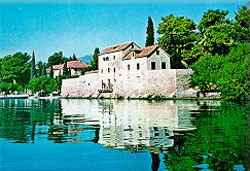
Miljenko's Castle built 1482
|
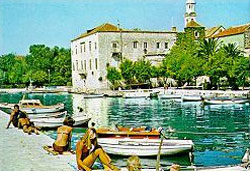
Dobrila's Castle built 1489
|
When the parents became
aware of the children's love they put Dobrila under
a strict surveillance and sent Miljenko to Venice. Out
of spite Dobrila's father arranged his douther's marriage
to an older nobleman from Trogir. Informed of this Miljenko
returned on the day of marriage and at the most solemn
moment of the merriage ceremony prevented it to take
place. To punish her Dobrila's father decided to put
her into the convent at Trogir, and Miljenko tried to
hinder this by his sword. The court thereupon banished
Miljenko to the monastery on the little islet of Visovac,
where he meet a paesant woman, Dobrila's nurse, and
through her sent a message to his beloved to escape
from the convent, which she did. After receiving the
news of Dobrila's escape their parents were reconciled
and sent messengers to Visovac to bring back the unrepentant
lovers to Kastel-Luksic for a solemn marriage ceremony.
The lovers obeyed, but of a summer evening in August
1690, after the marriage and feast have taken place,
Dobrila's father out of revenge and hatred killed Miljenko
on a drawbridge in front of his castle. In her deep
sorrow Dobrila went out of her senses, became ill and
died. Her last wish was to be buried with Miljenko in
the same grave in the small church, where one can still
today read the inscription over their grave "Peace
to the lovers".
This true story inspired three works of art: a novel,
play and opera. |
 |
Church with Miljenko's and Dobrila's
grave (1690) |
|
 |
